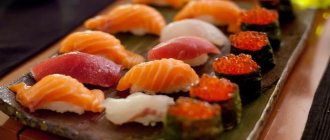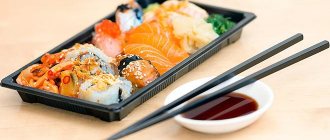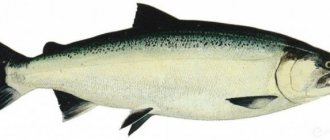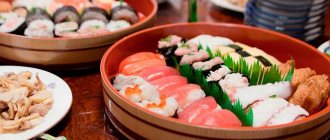In the era of globalization, the national traditions of various countries and cultures become “public property”. The interweaving of traditions is clearly visible in cooking and public catering culture. Asian cuisine has begun to occupy an important place in the diet of modern people, both Russians and Europeans or Americans. The most fashionable modern Asian dishes have become sushi and rolls - a symbol of Japanese cuisine. The roots of this dish are indeed connected with Japan, but modern sushi is a truly international phenomenon.
In the everyday life of a modern person, “sushi and rolls” are almost synonymous. When a person says “I’ll order sushi,” then, as a rule, the majority of his order will not be sushi, but rolls. In fact, these are different dishes. Sushi is a piece of fish placed on a lump of rice, and rolls are rolls of rice with fish, wrapped in nori. Rolls, like gunkans, can be considered “one of the varieties” of sushi.
A kind of “substitution of concepts” was one of the consequences of the popularization of this dish, and somewhat complicated the search for the historical and cultural origins of sushi and rolls in Japanese culture. Those rolls that you and I are used to ordering for delivery or in “Japanese restaurants” these days have a much more indirect relationship to Japan than sushi itself.
In this article we set ourselves not a culinary, but rather a historical and cultural task. We will not go into the intricacies of preparation and the features of various types of rolls and sushi, but will only try to trace individual milestones in the development of the main “trend” of Japanese cuisine.
Background of sushi. Fish storage method
The origins of the dish known as sushi date back to the early Middle Ages. His backstory begins not in Japan, but in China. According to the most popular version of the origin of sushi, it was in the Celestial Empire that a method of storing fish was invented, which gave rise to the future popular delicacy of “oriental origin.”
The Chinese came up with the idea of preserving and preserving the meat of freshly caught sea creatures by layering their carcasses with layers of rice. The two main components of the future popular dish reacted, the rice was fermented, its juices were absorbed into the fish, preventing it from spoiling.
Around the 7th century AD, the method of storing “fish in rice” gained popularity and became widely used in East Asian countries, including Japan.
Sometimes they write that the Japanese were among the first to use “canned rice”; some believe that the method first came from China to Thailand, and from there to the land of the rising sun. For us, it is not so important who exactly came up with the idea of storing fish in rice. It was the Japanese who went further than everyone else, eventually turning the method of preserving the product into a culinary recipe. There are several versions of the meaning of the word “sushi”; there is no exact interpretation of the hieroglyph meaning the dish. According to the most popular, “sushi” (or “sushi”) means “marinated fish.” This is not logical. After all, in the classic Japanese sushi recipe known today, the fish is raw. The answer is simple - the name refers to the origins of the dish, to the method of marinating.
Main types of sushi (sushi).
A separate very popular category of Japanese cuisine is sushi (in Russian common people - sushi).
" Nigirizushi " - molded sushi, i.e. are done by hand. A little wasabi is applied to an oblong lump of rice and a thin piece of filling is placed on top. Sometimes it is also tied with a thin ribbon of nori seaweed.
“ Temakizushi ” - handmade sushi without makisu (mat), rice and filling are wrapped in a sheet of nori in the form of small bags.
" Gunkan-maki " is a type of molded sushi. Gunkans are easy to prepare - they are prepared without makisu (this is a mat for making rolls). They resemble a “ship” in shape. Gunkans are prepared with chopped filling or caviar, surrounded by a strip of nori around a lump of rice.
Delicious recipe! Quick pies recipes with photos step by step
“ Makizushi or simply Maki ” is sushi in the form of a cylinder. Made using makisu. Those. The rice with the filling is wrapped in a sheet of nori seaweed using makisu and cut into 6-8 pieces. You can also wrap it in a thin Japanese omelette. Makizushi are also called rolls (“rolls” in the European style).
" Hosomaki " - thin rolls with a sheet of nori on the outside. Usually the size of these rolls is no more than 2x2 centimeters. The composition of such rolls: nori sheet, rice and one type of filling (this can be either seafood or vegetables, such as cucumber). Typical representatives are the Unagi roll (or unagi maki. The filling contains fried eel meat: eel and rice, wrapped on the outside in a sheet of nori) and kappa roll (another name is kappa maki. Cucumber and rice wrapped on the outside in a sheet of nori).
“ Uramaki (inside out rolls) ” – they are rolled in such a way that the rice is on the outside, and the filling is in the center, wrapped in a sheet of nori. These rolls are made from a small sheet of nori or half a large one. A typical representative of such rolls is Philadelphia rolls . How to cook uramaki is shown in this recipe - “Uramaki with cheese, crab meat, salmon and Japanese omelette” .
" Oshizushi " - sushi in the form of sticks. It is made using a device called oshibako. The filling is placed on the bottom of the oshibako, then the rice and under the press, rectangular cubes are obtained, which are then cut.
“ Chirashizushi ” is a plate of rice with filling scattered over it.
How “classic sushi” was formed.
Originally, the Chinese method suggested that rice was used only for storage, it was not eaten, fish was eaten, and the rice was thrown away. This approach to one of the most popular products in the world and an “integral” attribute of any Asian cuisine may seem strange from the point of view of culinary culture.
Rice also came to Japan from China and became an important part of the local food culture; it was impossible to imagine a Japanese table without rice; in this country, the word “gohan”, meaning “cooked rice”, is often noted in relation to the meal in general. If for Russians, according to the well-known saying, food is cabbage soup and porridge, then for the Japanese food means rice. And throwing away food is not rational.
The Japanese were the first to think of not just using rice for marinade, but eating it along with fish. This happened around the 14th century. Following the “pickling” method, this dish was dubbed “nare sushi”, that is, sour sushi, or sour marinated fish; the fermented rice released vinegar, adding sourness.
The first ancestor of sushi of the Middle Ages, it must be admitted, was a very specific drug; the dish had an unpleasant odor, reminiscent of something between “sour fish” and “rotten cheese.” A European, accustomed to thermally processing food, would “throw up” just from the aroma. But such a thing would never even have occurred to me.
By the 17th century the recipe was improved. Now boiled rice began to be “seasoned” with rice vinegar, the idea of making which again stems from the ancient method of preservation.
The “canonical” sushi recipe was formed at the beginning of the 19th century, during a period called the Edo era in Japanese history. The main city of the country, now Tokyo, was also called in those days. In this city there lived a cook named Yohei Hanai. He came up with the idea of putting raw fish on marinated rice, and the chef developed a “close to modern” version of sushi. Rice cooked in vinegar stuck together easily and had a more refined taste, which was successfully complemented by raw natural fish.
A new type of sushi, due to its compact size and shape that is convenient to hold in your hands, received the name “nigiri” , which literally means “hand-held sushi”. In the 19th century, sushi in Japan became increasingly popular among the wealthy and became the world's first fast food.
They began to be served as a snack during Kabuki theater performances. The performances lasted all day, and snacks were essential. The sushi invented by Yohei Hanai was perfect for this. In a sense, sushi for the Japanese has become an analogue of modern popcorn.
Risks of eating sushi [edit | edit code]
Like any dish prepared from raw or lightly cooked foods, sushi is perishable and, when stored, can become a breeding ground for the development of dangerous bacteria. Eating sushi for a long time and/or improperly stored can lead to a number of gastrointestinal diseases. Therefore, the shelf life of cooked sushi does not exceed several hours; the best option is to consume sushi immediately after preparation.
Sushi is a potential source of helminths, namely opisthorchis, tapeworm, nematodes [11] [ unauthorized source?
] . All of them can lead to a number of serious health problems (helminthiasis). Externally, infected fish are no different from healthy ones. Sauces, contrary to popular belief, do not solve the problem.
Due to the risk of infection with parasites, they prefer sea fish for sushi, which is much less likely to be infected, however, sea fish is not at all safe: nematodes, for example, affect many species of sea fish; according to some data, [11] herring in the Baltic Sea are infected by 30 %, in Northern - by 55% or more. The only way to protect against parasites (except for salting and heat treatment, which are unacceptable for making sushi) is freezing. According to SanPiN 3.2.1333-03, to disinfect fish, it is necessary to keep it cooled to a temperature of −18 °C for 36 hours or to a temperature of −27 °C for at least 12 hours (in European Russia, sushi is usually prepared from seafood , which are transported and stored deep frozen, or from salted fish that does not pose a danger). Sushi with hot smoked fish is safe against helminths - this smoking usually kills parasites.
Another risk factor may be the high content of heavy metals in sushi prepared from certain types of sea fish. Studies conducted in the USA [12] showed that the tuna from which sushi is made contains dangerous concentrations of mercury (to avoid harm to health, such sushi can be eaten no more than once every three weeks). Heavy metals are also found in other types of marine fish, usually large ones, with fish caught in the Atlantic Ocean more often showing high levels of mercury. Contamination of marine fish with mercury is associated with the practice of improper disposal of electrical appliances containing mercury, primarily fluorescent lamps [12]. The primary source of mercury is considered to be untreated wastewater from landfills, from which mercury enters ocean water, algae, and then spreads through the food chain and ultimately accumulates in dangerous concentrations in the bodies of the longest-living large predatory fish, which includes tuna.
The Dietitians Association of Australia states that excessive consumption of sushi made with nori may have harmful effects on the thyroid gland due to the excess iodine in nori. [13] One roll contains up to 92 mcg of iodine, while the recommended daily intake for an adult is only 150 mcg, so you can eat no more than two rolls a day without exceeding your iodine intake. [14] The association notes that in Australia, where the popularity of sushi has been growing significantly in recent years, 850 thousand people suffer from hyperthyroidism and more than 40 thousand new cases of the disease are recorded annually.
The background of rolls and the “strange substance” called nori.
Of all the Japanese dishes that have spread throughout the modern world, the most popular are the Philadelphia, California and Canada rolls. All three names are North American place names. A reasonable question arises: where do Japanese dishes get their American names?
The answer is simple - there is a distinct American trace in the international fame of the dishes that have become the “main symbols” of Japanese cuisine. In some articles on the Internet you can read that “rolls” in their modern form were invented in America, hence the names. In fact, this statement is only partly true. It was the Japanese who came up with the idea of wrapping rice and fish rolls. True, these Japanese rolls are vaguely reminiscent of what we are used to eating today. For example, a Japanese person will laugh for a long time if you tell him that vegetables or cream cheese are added to a Japanese dish called roll. The word itself – roll – is a Western name for the dish. In Japan it is called "makizushi".
maki rolls
The word “maki” is one way or another present in the “Japanese” names of all modern varieties of rolls. Maki is a small roll with one type of filling. It is also called a traditional roll, which can be safely considered an authentic Japanese invention.
When attempting to recreate the origins of the rolls, it is important to remember a secret ingredient that is used in most Japanese dishes known collectively as sushi. These are compressed edible seaweeds from the porphyry family, which are known as “nori” and are sold today in leaf form in supermarkets. In the USA, as in the rest of the world, these algae clearly appeared not without Japanese participation.
Historically, the pioneers of nori as an edible product and wrapping material were, however, not the Japanese, but their neighbors, the Chinese. In Chinese sources you can find references to nori as early as the 6th century. There is a version that Chinese fishermen were the first to “wrap fish in seaweed.” To keep their catch fresh, they caught seaweed, dried it and covered the fish with it.
Having come from China to Japan, the culture of eating nori became widespread here, including the use of seaweed as an “edible mold” in which sushi was placed.
What are rolls
Rolls are also a traditional dish used in Japanese cuisine. But it can be considered a modified version of sushi, brought to perfection.
The name of this dish comes from the English word, which literally sounds like “spin.” The Japanese do not use this word; instead, they call this dish differently - maki or makizushi. To define in more detail what rolls are, it is advisable to delve into their differences from sushi.
From Japan to America. How sushi and rolls became a fashionable international dish.
The traditions of Japanese cuisine first crossed the ocean and became known in Europe and America at the beginning of the 20th century. During the Meiji era, many Japanese emigrated to the United States and Europe. It was thanks to emigrants that sushi acquired its current universal international shape.
After the first penetration of land "to the west", their fame did not last long. The fact that sushi did not immediately gain recognition outside of Japan is often attributed to political reasons. In the first half of the 20th century, Japan had a dubious reputation on the world stage, the Japanese opposed the United States in World War II, and it was quite natural that Americans did not want to eat Japanese food.
The “hits” of Japanese cuisine gained real popularity in the 70s and 80s of the 20th century, and then its modern variations arose. It was unusual for Europeans and Americans to eat raw fish, and they replaced it with lightly salted fish, adding some new ingredients to the rolls.
The black nori wrapper also seemed strange to some residents of Western countries, so it was in America that the so-called “uromaki” - rolls with the rice facing out - arose. In 1973, “turn the roll” was invented by an emigrant chef working in Los Angeles, Ichiro Mashito. The chef decided to “experiment” and added the “exotic” avocado fruit inside the roll, paying attention to its suitable structure. This is how one of the most popular rolls appeared, named “ California” after the place of its invention.
Other currently popular rolls have appeared in a similar way - the idea, tradition and methodology in them are Japanese, but the filling and implementation are North American.
The popularization of Japanese cuisine in general, and roll sushi in particular, is often associated with the name of Nobu Matsuhisa. He was born and raised in Japan and, already as a cook, moved to live in Latin America, in the capital of Peru, the city of Lima. In a sunny Spanish-speaking country, the Japanese began to promote the traditions of their native cooking and “adapted” local products for Japanese dishes. After Peru he lived in Chile and the USA. In America, Matsuhisa met and became friends with Robert de Niro. The Hollywood artist liked the cuisine from the eastern country, and he contributed to an increase in interest in sushi and its many varieties among American celebrities. Matsuhisa even appeared on the silver screen in one of Michael Scorsese's films.
Actor Robert De Niro (left) and chef Nobu Matsuhisa (right)
Together, De Niro and Matsuhisa opened several establishments; in the late 80s and early 90s they gained popularity in the states. The Japanese chef has become an iconic figure in the history of not only national, but also world culinary. He is considered one of the main super-chefs of our time, and the name Matsuhisa has become a brand inextricably associated with Sushi.
Because of the Soviet “Iron Curtain,” sushi and rolls came to Russia late in a version “adapted” for Westerners. Although the first Japanese restaurant in Moscow, Sakura, opened quite early - in 1980. You understand what kind of era it was. For the Soviet people, whose daily life was constant in scarcity, the mysterious Japanese delicacies became unaffordable exoticism.
Most Soviet and then Russian citizens had never heard of what sushi was at least until the mid-1990s. But the real boom began only in the current millennium.
Many Russians still treat “raw fish” with distrust, and will not go to any Japanese restaurant. However, ordering sushi for lunch at the office or on a holiday has become a good tradition.
The main filling for the rolls is seafood, which is not typical for the traditional diet of Russian people. They are usually not cheap. The high cost of this dish in deliveries and cafes encourages housewives to experiment and try to roll the rolls themselves.
Russian people are also rich in imagination and can think of wrapping anything in a roll, for example, lake pike, and instead of masago caviar, you can use dill grown in the garden as a topping.
So, Russian families have probably already “invented” new types of rolls, which neither the Japanese nor the Americans even know about. And the dish, which arose from “rice rotting in fish,” has become truly popular.
Tell friends:
Anatoly Yagodkin
Historian, journalist, popularizer of science, music and literary critic. Creator, administrator and main author of the HUMANITAR-MEDIA portal
Ingredients [ edit | edit code]
All types of sushi consist of a base ingredient - specifically prepared rice, to which other ingredients are added.
Sushi rice [edit | edit code]
Sushi
prepared from white fine-grained Japanese rice mixed with a specially made sauce made from rice vinegar, sugar, salt - this rice is called sumeshi (Japanese 酢飯, literally “vinegar rice”).
fusion cuisine
restaurants use short grain brown rice and wild rice. Rice is cooked in Japanese style (with preliminary washing, in a closed container with a minimum amount of water, without salt, the water is first infused on kombu sheets), and before preparing sushi, it is allowed to cool in a special wooden tub - hangiri (or cooled, for example, by fanning the rice fan). Sushi rice should generally be used as soon as it has reached room temperature.
Nori [edit | edit code]
Nori
are dried seaweed leaves that are used to prepare
makizushi
,
gunkanmaki
,
temakizushi
and some
nigirizushi
.
Fillings [edit | edit code]
- Fish
Only ocean fish, which usually have significantly lower levels of parasites, can be used raw as a filling for sushi, however, even such popular fish as salmon and tuna can only be used raw after deep freezing. River fish, in which the presence of parasites is much more likely, is always cooked. The most commonly used fish are tuna, yellowtail, snapper, eel, mackerel and salmon.
- Seafood
Other commonly used seafood: squid, octopus, shrimp, fish roe, sea urchin ( uni
) and various types of mollusks. However, oysters are not used in sushi because their taste does not combine with the taste of rice.
- Vegetables
Pickled daikon ( takuan)
) in
Shinko maki
, various pickled vegetables (
tsukemono
), fermented soybeans (
natto
) in
natto maki
, avocado in California rolls, cucumber in
kappa maki
, asparagus, yams, tofu, pickled
ume
- umeboshi (Japanese: 梅干), pumpkin (
kampyo
), burdock (
gobo
) and sweet corn mixed with mayonnaise.
- Eggs
Eggs (in the form of a slightly sweetened, layered omelette called 玉子焼きtamagoyaki
).
The omelette is traditionally prepared in a rectangular pan (巻き焼き鍋makiyakinabe
) and is used to form a pouch for the rice and toppings.
The ingredients of a Japanese omelet are soy sauce, eggs, Japanese mayonnaise, Hondashi, and sugar. When making fukusazushi
, a paper-thin omelet can replace a sheet
of nori
.
- Red meat
Beef, ham, sausage and horse meat, often slightly cooked.
Seasonings [edit | edit code]
- Soy sauce
(Japanese: 醤油
sho:yu
) - Wasabi
(Japanese: 山葵) is the ground root of the wasabi plant (a special type of horseradish, Eutrema japonica). Real wasabi is believed to kill germs in raw fish. In the vast majority of cases, both in Japan and abroad, imitation wasabi based on mustard or horseradish is used under the guise of wasabi. - Gari
(Japanese: がり) - pickled ginger. - Rice vinegar
or special seasonings with rice vinegar are added to rice to give it a specific taste.
Specifics of Japanese sushi
This dish is considered important in Japan because special attention is paid to its appearance. The Japanese believe that sushi should look perfect, so they use not only fresh, but also beautiful ingredients to prepare it.
In most cases, fish and other seafood are used raw, less often smoked. Sometimes the ingredients are salted, although in Japan they do not do this. As noted above, the main thing for the Japanese is the freshness of the products from which the dish is made.
The peculiarity of sushi is that on the table they can be both a main course and an appetizer. Sometimes, instead of fish or seafood, vegetables, such as fresh cucumber, are added to this dish. Also, modern chefs prefer to pamper restaurant guests with sushi made from smoked meats or even fruits.
Let's understand the terms
Even knowing the lexical meaning of the word “sushi,” many people classify all kinds of snacks from Japanese cuisine as sushi. Both rolls and sushi all fit the same mold (this attitude towards an authentic dish can be seen in restaurants where it is served - almost everywhere). Which often irritates connoisseurs and culture bearers and Japanese culinary specialists. Meanwhile, remembering the difference is not at all difficult. Sushi is a small ball of rice with a piece of fish, seafood or cheese on top. A roll is a roll, its shell is seaweed, and inside there is rice and other filling components. These dishes also differ in the method of preparation. Sushi is made only by hand; a special bamboo mat is required to roll the rolls. By the way, it is thanks to the wrapping that there are many times more varieties of rolls than types of sushi.
What are the benefits of the dish?
The benefits of sushi for human health are difficult to overestimate. Those who eat them often are unlikely to complain of headaches or heart problems. Regular consumption of seafood helps stimulate brain function, improve overall well-being and strengthen the immune system. In addition, eating this dish can:
- Improve and normalize intestinal function.
- Positively affect the condition of hair and skin.
- Strengthens bones and teeth.
- Positively affects the development of intelligence, etc.
- Increases life expectancy. As proof, we can cite official statistics: in Japan, the average life expectancy is 80 years. This is much more than in all countries of the post-Soviet space.
Caring for the preservation of sushi making traditions
In the 1990s, in order to understand Japanese traditions and the peculiarities of preparing national dishes, Japanese sushi makers working in the United States teamed up with the DC Sushi Society association. And every year on September 1, Sushi Day is held in all restaurants included in this establishment. On this holiday, chefs prepare sushi at one time for a single price.
Since 2006, the Japanese government began checking all foreign restaurants stylized as Japanese ones. This was preceded by a scandal when the Japanese Minister of Agriculture, during an official visit to the United States, visited a similar establishment and was horrified to see that sushi was served with Korean dishes. Since then, only establishments that have passed inspection and received an insignia in the form of a branch of cherry blossoms can be called Japanese restaurants. In this way, the Japanese maintain their national pride and do not allow their idea of real sushi to be distorted.
A little history
By the way, in traditional Japanese cooking, dishes were originally prepared from just such fish, and the rice involved in its preparation was thrown away: it became sticky and acquired an extremely unpleasant smell. It is noteworthy that such preservation was originally invented in South Asia, and came to Japan through China and Thailand around the seventh century. Moreover, in China this technology was later completely forgotten.











